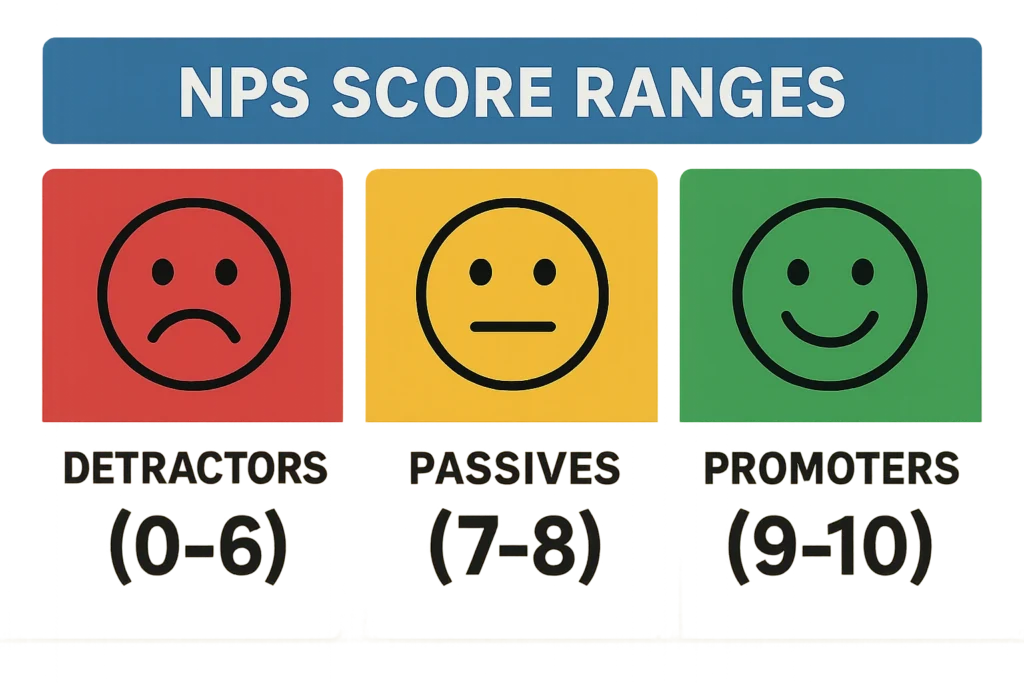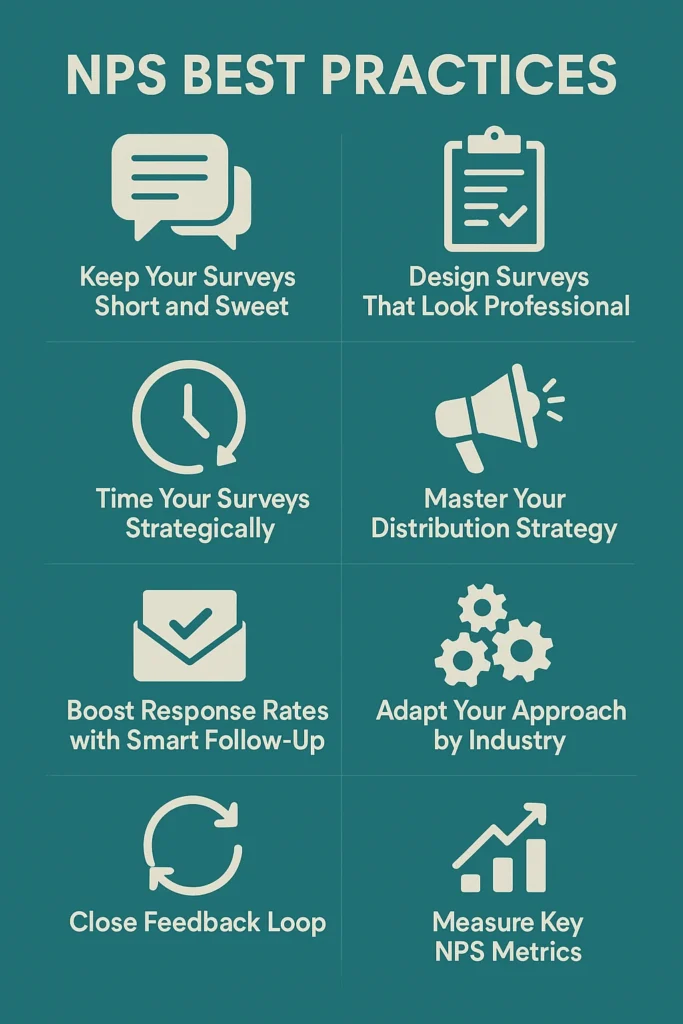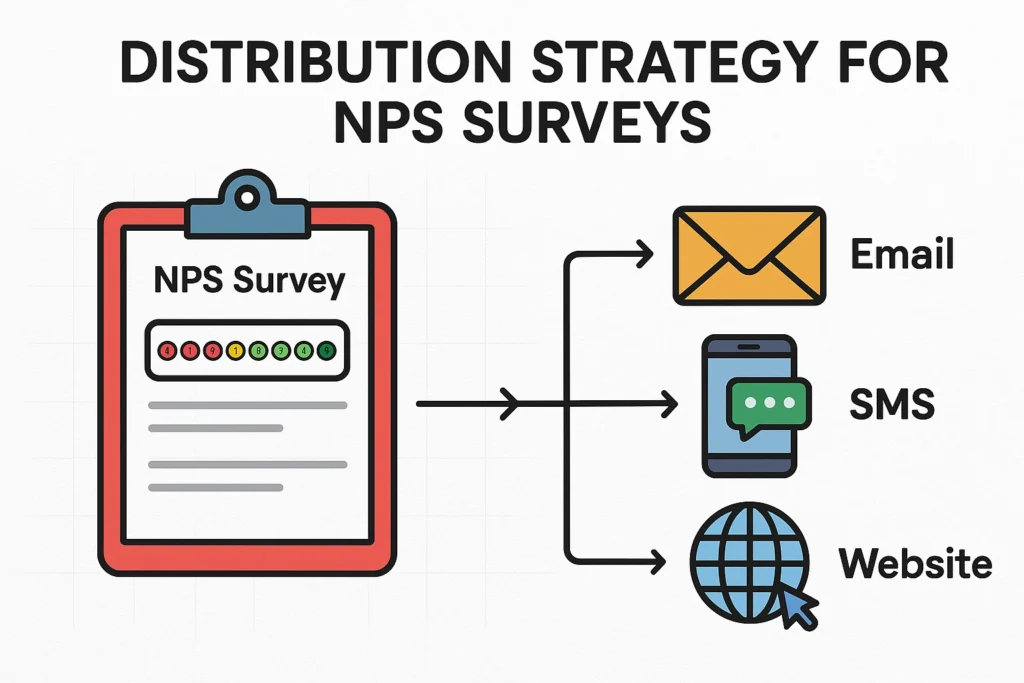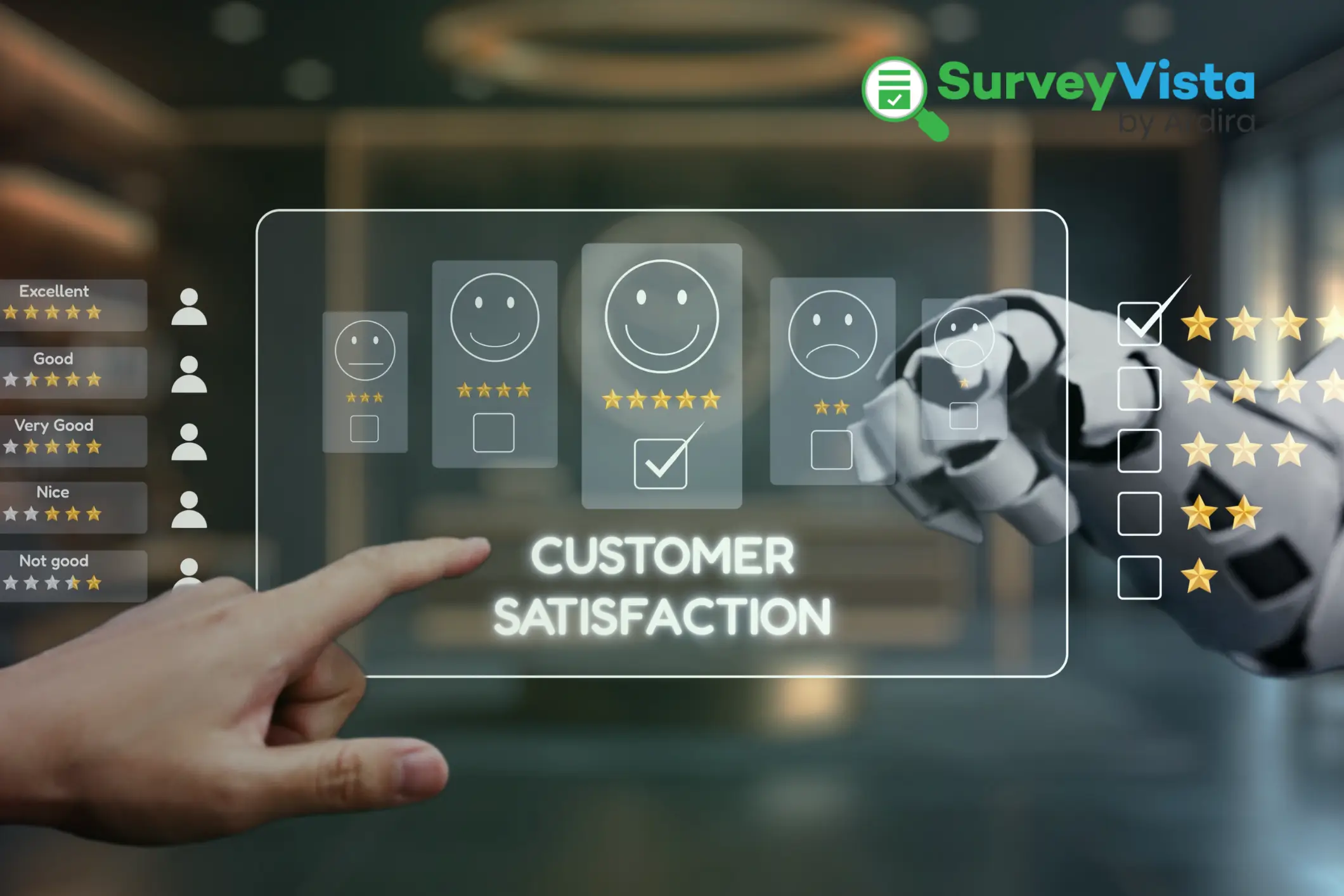Getting customer feedback shouldn’t feel like pulling teeth. Yet many organizations struggle with low response rates, unclear insights, and surveys that don’t translate into meaningful action.
The good news? There’s a proven playbook for NPS success. Based on extensive research from industry leaders, here are the essential best practices that separate high-performing NPS programs from the rest.
What is an NPS Survey?
Net Promoter Score might sound like another metric to track, but it’s actually your early warning system for customer loyalty.
Think of NPS as a temperature check on how much your customers genuinely champion your brand. The magic happens through one deceptively simple question: “How likely are you to recommend us?” Respondents score you from 0 to 10, and their answers reveal everything.
Here’s how the math breaks down. Your promoters (scoring 9-10) are your superfans—they’re actively singing your praises. Passives (7-8) are satisfied but won’t go out of their way for you. Detractors (0-6) are at risk of churning and might even warn others away.

Your NPS score lives between -100 and +100. Calculate it by subtracting your detractor percentage from your promoter percentage.
What are the NPS Best Practices I Need to Know?

Keep Your Surveys Short and Sweet
The Magic Number is 3-6 Questions
Research consistently shows that surveys with 3-6 questions achieve response rates between 40-60%. Go beyond this range and you’ll watch completion rates plummet.
Your core NPS question should always come first. Follow it with 1-2 supporting questions that help you understand the “why” behind the score. Success comes from keeping surveys brief and focused on what matters most.
Make Every Question Count
Don’t ask questions just because you can. Each question should serve a specific purpose in understanding customer sentiment or driving action. Crafting effective NPS questions requires careful consideration of what insights you actually need.
Optional comment fields work well—about 44% of respondents use them when available. Just make sure they’re clearly marked as optional to avoid survey abandonment.
Use Clear, Simple Language
Skip the corporate jargon and complex phrasing. Your customers should immediately understand what you’re asking without having to read questions twice.
Instead of “How would you rate your satisfaction with our solution’s implementation methodology?” try “How satisfied were you with setting up our product?”
Design Surveys That Look Professional
Brand Consistency Matters
Customers notice poor design just as much as poorly written questions. Your surveys should feel like a natural extension of your brand experience.
Use your company colors, logo, and maintain the same tone of voice you use in other customer communications. This builds trust and increases completion rates. Consider A/B testing survey formats to find what resonates best with your audience.
Optimize for Mobile
More customers access surveys on mobile devices than ever before. Ensure your surveys display properly across different screen sizes and maintain functionality on smartphones and tablets.
Responsive design isn’t optional—it’s essential for reaching your entire customer base. Test your surveys on multiple devices before sending them out.
Time Your Surveys Strategically
Strike While the Iron is Hot
For transactional surveys, timing is everything. Send surveys within 24-48 hours of the customer interaction while the experience is still fresh. The key is collecting feedback at optimal touchpoints when customers can provide the most accurate responses.
Wait too long and you’ll get feedback based on reconstructed memories rather than actual experiences. Think about your own experience as a customer—how accurately could you rate a restaurant meal from three weeks ago versus one from yesterday?
Find Your Relationship Survey Rhythm
Quarterly relationship surveys hit the sweet spot for most organizations. This frequency allows enough time for meaningful changes in customer sentiment while maintaining regular engagement.
More frequent surveys risk fatigue. Less frequent surveys miss important sentiment shifts that need immediate attention. Optimizing survey length and timing helps maintain this delicate balance.
Avoid Busy Periods
Retail companies should skip major shopping seasons. B2B organizations need to consider budget cycles and industry conference seasons.
Holiday periods are generally poor timing across all industries due to competing priorities and reduced business activity.
Master Your Distribution Strategy

Email Still Rules
Email remains the most effective distribution channel for most organizations. Focus on optimizing subject lines, sender reputation, and deliverability.
Avoid promotional language that triggers spam filters. Send from recognized company email addresses with established sending histories.
Leverage Automation and Triggers
Set up automated survey delivery based on customer actions, milestones, or time intervals. This ensures surveys align with meaningful experiences rather than arbitrary schedules. For Salesforce users, setting up automated NPS surveys in Salesforce streamlines this entire process.
Common triggers include purchase completion, service delivery, support resolution, and subscription renewals. Automation isn’t just about convenience—it’s about relevance.
Personalize Your Invitations
Generic survey invitations get ignored. Include relevant context like recent purchase history, service interactions, or product usage patterns.
This demonstrates attention to individual customer relationships and makes survey requests feel more valuable and relevant. “We’d love your feedback on your recent order #12345” beats “Please take our customer survey” every time.
Boost Response Rates with Smart Follow-Up
Implement Strategic Reminders
One reminder can significantly boost response rates. Time it appropriately—shorter intervals for transactional surveys, longer cycles for relationship surveys.
Acknowledge the previous invitation while providing additional motivation for participation. The reminder should feel helpful, not pushy.
Try Multiple Channels for Non-Responders
Some customers prefer different communication methods. Consider in-app notifications, SMS, or phone calls for high-value accounts that don’t respond to email.
Coordinate carefully to avoid overwhelming customers with multiple simultaneous requests. Space out different channel attempts by at least a few days.
Adapt Your Approach by Industry
Healthcare Requires Special Consideration
Patient privacy concerns and HIPAA compliance add complexity to healthcare NPS programs. Survey timing must account for treatment outcomes and recovery periods.
Many patients prefer phone-based feedback over digital channels due to the personal nature of healthcare relationships.
SaaS Companies Can Go In-App
Software companies benefit from in-product survey delivery where customer experiences are fresh and relevant. This eliminates external communication barriers.
Timing should align with value realization milestones, which vary significantly across different software categories and user types.
CPG Faces Distribution Challenges
Consumer packaged goods companies need creative approaches like QR codes on packaging, retailer partnerships, and social media engagement to reach end customers.
Channel partner feedback becomes critical since retailer relationships significantly influence end-customer satisfaction.
Close Feedback Loop
Don’t just collect scores—act on them. Implement systems that automatically trigger follow-up activities based on survey responses.
Reach out immediately to dissatisfied customers, recognize promoters, and conduct systematic root cause analysis for recurring issues. Customers who see their feedback lead to actual changes become more engaged and more likely to participate in future surveys.
Measure Key NPS Metrics
Don’t treat all customers the same in your analysis. Segment by demographics, behavior, industry, geographic region, and lifecycle stage to uncover meaningful insights.
Different customer groups have different satisfaction drivers and loyalty patterns that require targeted approaches. Segmentation reveals the specific actions that will have the biggest impact on different customer groups.
Track Trends Over Time
Establish consistent measurement methodologies and baseline periods that enable reliable trend identification. Account for seasonal variations, market changes, and internal improvement efforts. Creating actionable NPS reports helps transform raw data into strategic insights.
Longitudinal analysis provides insights that support strategic planning and improvement initiative evaluation. A single NPS score is just a snapshot—trends tell the real story.
Connect Scores to Business Outcomes
The most successful NPS programs correlate satisfaction metrics with business outcomes like revenue growth, customer retention, and market share expansion. Real-world NPS implementation examples demonstrate how organizations successfully connect feedback to financial results.
This connection demonstrates ROI and helps prioritize customer experience investments based on potential financial impact. It transforms NPS from a “nice to have” metric into a business-critical measurement.
Why SurveyVista Makes NPS Implementation Easier
Traditional survey tools force you to juggle multiple platforms and deal with data integration headaches. SurveyVista eliminates these friction points by keeping everything inside Salesforce where it belongs.
Your feedback data flows instantly into existing workflows and automation without API complications or sync delays. No third-party servers, no external hosting, no compliance nightmares.
This native integration means you can implement these NPS best practices without the technical complexity that typically slows down feedback programs. When you’re ready to evaluate options, consider choosing the right NPS software that supports these proven methodologies.
Ready to drive customer-centric growth with a feedback platform that actually works with your existing processes? SurveyVista’s 100% Salesforce-native approach makes it possible to collect, integrate, understand, and act on customer feedback faster than ever before.
Frequently Asked Questions
How often should I send NPS surveys to my customers?
For relationship surveys, quarterly works best for most organizations. For transactional surveys, send within 24-48 hours of the customer interaction. This balance maintains engagement without causing survey fatigue while capturing feedback when experiences are still fresh.
What’s the ideal length for an NPS survey?
Keep surveys to 3-6 questions maximum. Start with your core NPS question, then add 1-2 supporting questions to understand the “why” behind scores. This approach achieves 40-60% response rates while respecting customers’ time.
How can I improve my NPS survey response rates?
Focus on timing, personalization, and follow-up. Send surveys when experiences are fresh, personalize invitations with relevant context, and send one strategic reminder. Mobile optimization and professional design also significantly impact completion rates.
Should I segment my NPS data analysis?
Absolutely. Segment by demographics, behavior, industry, and lifecycle stage to uncover meaningful insights. Different customer groups have different satisfaction drivers, so segmented analysis reveals specific actions that impact each group rather than generic improvements.
How do I close the feedback loop with NPS survey respondents?
Implement automated follow-up systems based on responses. Reach out immediately to dissatisfied customers, recognize promoters, and conduct root cause analysis for recurring issues. Show customers their feedback leads to actual changes.
More Like This

Rajesh Unadkat 
Founder and CEO
Rajesh is the visionary leader at the helm of SurveyVista. With a profound vision for the transformative potential of survey solutions, he founded the company in 2020. Rajesh's unwavering commitment to harnessing the power of data-driven insights has led to SurveyVista's rapid evolution as an industry leader.
Connect with Rajesh on LinkedIn to stay updated on the latest insights into the world of survey solutions for customer and employee experience management.



